Paul Emil von Lettow-Vorbeck - Picture
More about World War 1
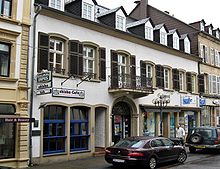
|
|
Paul Emil von Lettow-Vorbeck
Nickname: Der Lowe von Afrika
Place of birth: Saarlouis
Place of death: Hamburg
Allegiance: German Empire
Years of service: 1890-1920
Rank: Generalmajor
Awards: Pour le Mérite mit Eichenlaub
Paul Emil von Lettow-Vorbeck (20 March 1870 - 9 March 1964) was a general in the Imperial German Army and the commander of the German East Africa campaign. Essentially undefeated in the field, General von Lettow-Vorbeck was the only German commander to successfully invade British soil during the First World War.
The East African campaign was essentially about a “modestly immense Allied army” that was engaged by “a midget German force led by an obscure Prussian officer who could have conducted post-graduate courses in irregular warfare tactics for Che Guevara, General Giap and other more celebrated but far less skilled guerrilla fighters.” Lettow-Vorbeck’s exploits in the African bush have come down “as the greatest single guerrilla operation in history, and the most successful.”
Early life

Picture - Birth house in Saarlouis
Paul Emil von Lettow-Vorbeck was born into the Pomeranian lower nobility while his father was stationed as an army officer at Saarlouis in the Prussian Rhine Province. He was educated in boarding schools in Berlin and joined the corps of cadets at Potsdam and Berlin-Lichterfelde. In 1890 he was commissioned a Leutnant in the Imperial German Army.
Military career
In 1900, Lettow-Vorbeck was posted to China as a member of the international alliance forces to quell the Boxer Rebellion. He was next posted to Africa.
Beginning in 1904 he was assigned to German South-West Africa (now Namibia), during the Namaqua and Herero insurrection. However, he did not participate in the subsequent genocide. Having suffered injuries to his left eye and chest, he was evacuated to South Africa for treatment and recovery.
In 1907 he was promoted to major and assigned to the staff of 11th Army Corps. From March 1909 to January 1913 Lettow-Vorbeck was commander of the marines of II. Seebatallion [2nd Sea Battalion] at Wilhelmshaven in Lower Saxony, Germany. As a lieutenant colonel, in October 1913 he was appointed to command the German colonial forces known as the Schutztruppe (protection force) in German Kamerun (today's Cameroon plus a portion of Nigeria). Before he could assume this command, however, his orders were changed and he was posted - effective 13 April 1914 - to German East Africa, the mainland of present Tanzania.
World War I
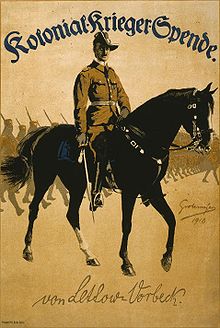
Picture - World War I poster of German General Paul von Lettow-Vorbeck on horseback leading African soldiers. Text at top reads Colonial War Funds; on bottom is facsimile of von Lettow-Vorbeck's signature
In August 1914, during the early phases of the World War I, Lettow-Vorbeck was the commander of a small garrison of just 2,600 German nationals and 2,472 African soldiers in 14 Askari field companies. Realising the need to seize the initiative, he ignored orders from Berlin and the colony's governor, Heinrich Schnee, who had insisted on neutrality for German East Africa. Lettow-Vorbeck simply ignored the governor and prepared to repel a major amphibious assault on the city of Tanga. The attack began on 2 November 1914, and for the next four days he fought one of his greatest battles. He then assembled his men and their scant supplies to attack the British railways in East Africa. He scored a second victory over the British at Jassin on 18 January 1915. These victories gave him badly needed modern rifles and other supplies, as well as critical boost to the morale of his men. However, Lettow-Vorbeck also lost many experienced men, including the "splendid Captain Tom von Prince," whom he could not easily replace.
Lettow-Vorbeck's plan for the war was quite simple: knowing that East Africa would only be a sideshow, he determined to tie down as many British troops as he could. He intended to keep them away from the Western Front, and in this way contribute to Germany's eventual victory.
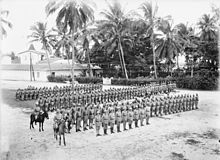
Picture - Schutztruppe Askari Company (1914)
Lettow-Vorbeck knew he could count on his highly motivated officers (their casualty rate was certainly proof of that). As a consequence of costly personnel losses, he afterwards avoided direct engagements with British forces, instead directing his men to engage in raids into British East Africa (modern Kenya), Uganda and Rhodesia, targeting forts, railways and communications - all with the goal of forcing the Entente to divert manpower from the main theater of war in Europe. He realized the critical needs of guerrilla warfare in that he used everything available to him in matters of supply.
The Schutztruppe recruited new personnel and expanded to its eventual size of some 14,000 soldiers, most of them Askari, but all well-trained and well-disciplined. Lettow-Vorbeck’s fluency in the Swahili language earned the instant respect and admiration of his African soldiers; he appointed black officers and "said - and believed - 'we are all Africans here'." "It is probable that no white commander of the era had so keen an appreciation of the African’s worth not only as a fighting man but as a man."
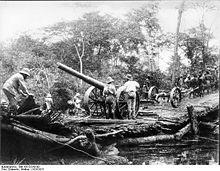
Picture - Konigsberg guns on land
He gained the men and artillery of the German cruiser SMS Konigsberg (scuttled in 1915 in the Rufiji River delta) which had a capable crew under commander Max Looff, as well as its numerous guns, which were converted into artillery pieces for the land fighting, which would be the largest standard land artillery pieces used in the East African theater. In March 1916 the British under Gen. J.C. Smuts launched a formidable offensive with 45,000 men. Lettow-Vorbeck patiently used climate and terrain as his allies while his troops fought the British on his terms and to his advantage. The British, however, kept on adding more troops and forcing Lettow to yield territory. Nevertheless, he fought on, including a pivotal battle at Mahiwa in October 1917 where he lost 519 men killed, wounded or missing and the British 2,700 killed, wounded or missing. After the news of the battle reached Germany he was promoted to Generalmajor. The British would recover their losses and continue to hold an overwhelming manpower advantage; for the Schutztruppe it was serious, there were no reserves to again fill the ranks.
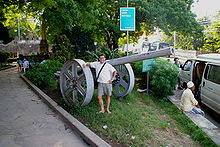
Picture - Konigsberg gun today in Mombasa
Lettow-Vorbeck now began a forced withdrawal to the south, with his troops at half rations and the British in pursuit. On 25 November 1917 his advance column waded across the river Rovuma into Portuguese Mozambique. In essence he cut his own supply lines and the Schutztruppe caravan became a nomadic tribe. On their first day across the river they attacked the newly replenished Portuguese garrison of Ngomano and solved all their supply issues for the foreseeable future. When they captured a river steamer with a load of medical supplies, including quinine, at least some of their medical problems were no more. For almost an entire year they had now lived off the land, but mainly with provisions captured from the British and Portuguese; they had replaced their old rifles with new equipment and acquired machine guns and mortars after capturing Namakura (Nhamacurra in modern Mozambique) in July 1918. At the end they had more ammunition than they could carry.

Picture - Lettow surrendering his forces to the British at Abercorn, as drawn by an African artist
On 28 September 1918 von Lettow again crossed the Rovuma and returned to German East Africa with the British still in pursuit. He then turned west and raided Northern Rhodesia, thus evading a trap the British had prepared for him in German East Africa. On 13 November 1918, two days after the armistice, he took the town of Kasama which the British had evacuated, and continued heading south-west towards Katanga. When he reached the Chambeshi River on the morning of 14 November, the British magistrate Hector Croad appeared under a white flag and delivered a message from the allied General van Deventer informing him of the armistice. Lettow-Vorbeck agreed to a cease-fire at the spot now marked by the Von Lettow-Vorbeck Memorial in present-day Zambia. He was instructed by the British to march north to Abercorn (now Mbala) to surrender his undefeated army, which he did there on 23 November. His remaining army then consisted of 30 German officers, 125 German non-commissioned officers and other enlisted ranks, 1,168 Askaris and some 3,500 porters.
The East African war and the population
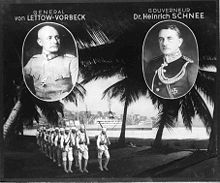
Picture - General von Lettow-Vorbeck and colonial Governor Heinrich Schnee
The British and Belgian invasions of German East Africa set off a chain of events with devastating ramifications for the natives and their German overlords. The invasions caused interruptions throughout the colony so that the land no longer “basked in a climate of plenty.”
As military commander, Lt. Col. von Lettow-Vorbeck’s first obligation was to his army over the objections of Governor Heinrich Schnee. The governor regarded war as the worst possible calamity that could befall German East Africa; it would “undo everything his social and economic reforms had accomplished.” Lettow-Vorbeck knew he would have to give ground and escape confrontations with Allied forces. He thus established food depots along his intended line of march from Neu Moshi to the Uluguru Mountains, and if the neighboring villages were near starvation, that was a misfortune of war.
Hardly any aid from Germany could penetrate the British blockade to alleviate the enormous supply deficiencies, and only two blockade runners succeeded in reaching the colony. On 14 April 1915 the freighter Kronborg arrived off Tanga at Manza Bay after a two months' journey from Wilhelmshaven, and was promptly attacked by the British cruiser Hyacinth. Fortunately for the Germans, Kronborg had been scuttled by her captain to avoid a coal fire after repeated hits by the British cruiser and the ship settled in shallow water. Nearly its entire cargo could be salvaged. When the steamer Marie von Stettin arrived south of Lindi on 17 March 1916, its precious cargo of 1,500 tons was of only very modest help. A November 1917 attempt to resupply German forces by a Zeppelin airship failed. By late September 1916, all of coastal German East Africa, including Dar es Salaam and the Central Railway, were under British control, with the west occupied by Belgians; then during December 1917 the German colony was officially declared an Allied protectorate.
Lettow-Vorbeck and his caravan of Europeans, askaris, porters, women and children marched on, deliberately bypassing the tribal home lands of the native soldiers in an effort to forestall desertions. They traversed difficult territory, “swamps and jungles . . . what a dismal prospect there is in front of me [to succeed]” stated the Allied commander Gen. J.C. Smuts. But Smuts did not flinch. His new approach and objective was not to fight the Schutztruppe at all, but to go after their food supply. The end eventually came some time later with Smuts in London and Gen. J.L. van Deventer in command in East Africa.
In a 1919 book, Ludwig Deppe, a medical doctor campaigning with Lettow-Vorbeck and former head of the hospital at Tanga, looked back in rue and lamented the tragedy that was imposed by German forces on East Africa in their war with the invading Allies: “Behind us we leave destroyed fields, ransacked magazines and, for the immediate future, starvation. We are no longer the agents of culture, our track is marked by death, plundering and evacuated villages, just like the progress of our own and enemy armies in the Thirty Years' War.”
While there was German callousness and harshness, the new British or Belgian masters in German East Africa were by no means benevolent, either. They assumed no responsibility for African welfare and provided little assistance to the malnourished native population; indeed, when food ran short for the Allied formations “the British askaris fell back on the practice of attacking and looting villages.” When the worldwide Spanish influenza epidemic swept into eastern Africa in 1918-19 it struck down thousands with impartiality, native and European alike. The weakened state of many natives made them especially susceptible; this included the caged askaris and porters of the German Schutztruppe, which had been herded together at the Tabora POW camps.
Post-War career
After hostilities ended, the British transferred the German soldiers and POWs to Dar es Salaam for eventual repatriation. Lettow-Vorbeck tried to ensure decent treatment and the briefest time the German askaris would be caged at Tabora.
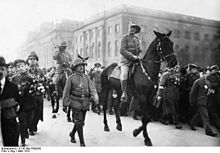
Picture - General Lettow-Vorbeck at Berlin parade (1919)
Lettow-Vorbeck returned home in early March 1919 to a hero’s welcome. On a black charger he led 120 officers of the Schutztruppe in their tattered tropical uniforms on a victory parade through the Brandenburg Gate which was decorated in their honor. Though he ultimately surrendered as ordered; he frequently won against great odds and was the only German commander to invade British territory successfully during World War I.
Paul von Lettow-Vorbeck was a daring yet prudent commander who showed uncanny ability to fight a guerrilla war in unfamiliar terrain. He was respected as a brilliant soldier and a first rate leader by his white officers, non-commissioned officers and Askaris - and beyond that, by his foes. In the field when rations had to be reduced and supplies dwindled,
it was a measure of the Askaris’ loyalty to their commander that they accepted the cuts and did not desert en masse. Some did desert, of course . . . [as did British, Belgian and Portuguese native troops]. But the German Askaris were by far the most loyal as well as the most effective, and it all went back to von Lettow’s brand of discipline, which bound him and his German officers as much as his black soldiers.
One of Lettow’s junior officers, Theodor von Hippel, used his experience in Africa to be instrumental in forming the Brandenburgers, the commando unit of the German Abwehr intelligence agency in World War II.
After his return from Africa, Lettow-Vorbeck married Martha Walroth in 1919; sons were born in 1921 and 1922 and a daughter in 1927. He participated in the chaotic politics of the Weimar Republic, and though he remained in the Army, only fourteen months after his return to Germany, he suppressed a communist uprising in Hamburg, and placed his troops at the disposal of monarchists during the Kapp Putsch. The failure of the putsch forced his resignation from the Reichswehr in May 1920. He then worked at Bremen as an import-export manager.
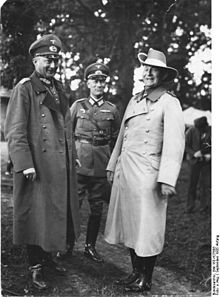
Picture - Lettow-Vorbeck (right) as guest of General GxĽnther von Kluge at army maneuvers in 1935
In June 1926 Lettow-Vorbeck met Sir Richard Meinertzhagen at Bremen, the British Intelligence officer whom he had fought a battle of wits with until Meinertzhagen was invalided to England in December 1916 (he was later posted to Palestine). Three years later, Lettow-Vorbeck accepted an invitation to London where he met for the first time face-to-face J. C. Smuts; Lettow and Smuts formed a lasting friendship. When Smuts died in 1950, Lettow-Vorbeck sent his widow a moving letter of sympathy. From May 1928 to July 1930 he served as a deputy in the Reichstag. Lettow-Vorbeck "distrusted [Adolf] Hitler and his movement," even though Hitler offered him the ambassadorship to Great Britain in 1935, which he "declined with frigid hauteur." During the 1960s, Charles Miller asked the nephew of a Schutztruppe officer, "I understand that von Lettow told Hitler to go fuck himself." The nephew responded, "That's right, except that I don't think he put it that politely."
After his blunt refusal, he "was kept under continual surveillance" and his home office was searched. The only rehabilitation due to his legendary standing among the populace came in 1938, when at age 68, he was named a General for Special Purposes, but was never recalled into active service.
By the end of World War II, Lettow-Vorbeck was destitute. His two sons, RxĽdiger and Arnd had both been killed in action serving in the Wehrmacht. His house in Bremen had been destroyed by Allied bombs, and he depended for a time on food packages from Meinertzhagen and Smuts. With the German economic miracle, he began to enjoy comfortable circumstances again. In 1953 he visited his other home, East Africa, where he was heartily welcomed by surviving Askaris who greeted him with their old marching song Heia Safari! and was received with full military honours by British colonial officials.
In 1964, Paul von Lettow-Vorbeck died in Hamburg. The West German government and the Bundeswehr flew in two former Askaris as state guests, so that they could attend the funeral of "their" General. Several officers of the Bundeswehr were assigned as an honor guard, and West Germany's Minister of Defense, Kai-Uwe von Hassel, gave the eulogy, saying that the deceased, "was truly undefeated in the field." Paul von Lettow-Vorbeck was buried in Pronstorf, Schleswig-Holstein in the cemetery of Vicelin Church.
Legacy
In the year of von Lettow-Vorbeck’s death, the West German Bundestag voted to deliver back pay to all surviving Askaris. A temporary cashier’s office was set up in Mwanza on Lake Victoria. Of the 350 old men who gathered, only a handful could produce the certificates that von Lettow had given them in 1918. Others presented pieces of their old uniforms as proof of service. The German banker who had brought the money came up with an idea. As each claimant stepped forward, he was handed a broom and ordered in German to perform the manual of arms. Not one man failed the test.
Four barracks of the German Army (Bundeswehr) at Leer, Hamburg-Jenfeld, Bremen and Bad Segeberg are named in his honor. With personnel reductions and base closures of 178 military installations, the only remaining one is the Lettow-Vorbeck-Kaserne in Leer, Ostfriesland.
In the spring of 2010, the City Council of Saarlouis renamed Von Lettow-Vorbeck-Straxźe. In Hanover, Lettow-Vorbeck Straxźe was renamed Namibia Straxźe. In Wuppertal, Cuxhaven, Monchengladbach, Radolfzell and Halle there are still streets named after General von Lettow-Vorbeck.
A species of the Dryosaurus was named after Lettow-Vorbeck.
In popular culture
General von Lettow-Vorbeck appears in a 1993 episode of the television series The Young Indiana Jones Chronicles. The episode, which was titled "The Phantom Train of Doom," begins with Indiana Jones as an officer in the Belgian Army during the First World War. Determined to destroy a Schutztruppe armored train, Indiana takes General von Lettow-Vorbeck (Tom Bell) hostage and attempts to return with him to Allied lines. When the Schutztruppe tracks them down, Indy draws his revolver in order to shoot the General, but ultimately decides to let him go. The General magnanimously gives him a compass and the two part as friends.
General von Lettow-Vorbeck is the protagonist of The Ghosts of Africa, a 1980 historical novel by Anglo-Canadian novelist William Stevenson about the East African Campaign which highlighted the long-distance resupply mission of the giant German rigid airship L.59.
General von Lettow-Vorbeck appears as a character in Peter Hoeg's short story, Journey into a dark heart, which is the opening story in his 1990 collection, Tales of the Night. In this story Hoeg imagines von Lettow-Vorbeck travelling through Africa by train at night accompanied by Joseph Conrad.
A German film, Lettow-Vorbeck: Der deutsch-ostafrikanische Imperativ, was produced in 1984.
Works
von Lettow-Vorbeck. Heia Safari! Deutschlands Kampf in Ostafrika [Heia Safari! Germany's Campaign in East Africa]. Leipzig: Hase & Kohler. 1920.
von Lettow-Vorbeck. Meine Erinnerungen aus Ostafrika. Leipzig: Hase & Kohler, 1920. Published in Great Britain as My Reminiscences of East Africa. London: Hurst & Blankett, 1920. U.S. edition entitled East African Campaigns with an introduction by John Gunther. New York: Robert Speller & Sons, 1957.
von Lettow-Vorbeck. Mein Leben [My Life]. Biberach an der Riss: Koehlers Verlag. 1957.
Battle of Tanga
East African Campaign (World War I)
German East Africa
German Colonial Empire
Von Lettow-Vorbeck Memorial
Hermann Detzner
Footnotes
Bibliography
Anderson, Ross. The Forgotten Front: The East African Campaign, 1914-1918. London: Tempus Publishing, 2004. ISBN 0-7524-2344-4.
Crowson, Thomas A. When Elephants clash. A critical analysis of Major General Paul Emil von Lettow-Vorbeck in the East African Theatre of the Great War. (Fort Leavenworth, Kansas. Faculty of the US Army Command and General Staff College, Masterarbeit, 2003). Washington, DC: Storming Media, 2003. NTIS, Springfield, VA. 2003. Microform-Edition.
Farwell, Byron. The Great War in Africa, 1914-1918. New York: W. W. Norton & Company, 1989, ISBN 0-393-30564-3.
Ferguson, Niall. Empire. The Rise and Demise of the British World Order and the Lessons for Global Power. New York: Basic Books. 2004. ISBN 0465023282
Garfield, Brian. The Meinertzhagen Mystery. Washington, DC: Potomac Books, Inc. 2007. ISBN 1597970417
Haupt, Werner. Deutschlands Schutzgebiete in xśbersee 1884-1918 [Germany’s Overseas Protectorates 1884-1918]. Friedberg: Podzun-Pallas Verlag. 1984. ISBN 3-7909-0204-7
Hoyt, Edwin P. The Germans who never lost. New York: Funk & Wagnalls. 1968, and London: Leslie Frewin, 1969. ISBN 0090964004. Note: This book is a study of Captain Max Looff and his crew of the light cruiser Konigsberg. The main sources are German admiralty records and published accounts by crew members. The book is listed here for reference only, since, as the author explains, he “had gotten off the track as far as [Paul Emil] von Lettow-Vorbeck was concerned.” Thus, all footnotes for “Hoyt” on this page refer to his book Guerilla. See SMS Konigsberg.
Hoyt, Edwin P. Guerilla: Colonel von Lettow-Vorbeck and Germany's East African Empire. New York: MacMillan Publishing Co., Inc. 1981; and London: Collier MacMillan Publishers. 1981. ISBN 0-02-555210-4.
LefÄ—vre, Eric. Brandenburg Division, Commandos of the Reich. Paris: Histoire & Collections. 2000 (translated from the French by Julia Finel. Originally published as La Division Brandenburg 1939-1945. Paris: Presses de la Cité. 1983). ISBN 2-908-182-734.
Louis, Wm. Roger. Great Britain and Germany's Lost Colonies 1914-1919. Oxford: Clarendon Press. 1967.
Miller, Charles. Battle for the Bundu: The First World War in German East Africa. London: Macdonald & Jane's, 1974; and New York: MacMillan Publishing Co., Inc. 1974. ISBN 0-02-584930-1.
Mosley, Leonard. Duel for Kilimanjaro. New York: Ballantine Books, 1963.
Paice, Edward. Tip and Run. The untold tragedy of the Great War in Africa. London: Weidenfeld & Nicolson, 2007. ISBN 0-297-84709-0.
Schulte-Varendorff, Uwe. Kolonialheld fxĽr Kaiser und FxĽhrer. General Lettow-Vorbeck - Eine Biographie [Colonial Hero for Kaiser and FxĽhrer. A General Lettow-Vorbeck Biography]. Berlin: Ch. Links Verlag, 2006. ISBN 3-861-53412-6.
Sibley, J.R. Tanganyikan Guerrilla. New York: Ballantine Books, 1973. ISBN 0345098013.
Stephenson, William. Der Lowe von Afrika. Der legendx¤re General Paul von Lettow-Vorbeck und sein Kampf um Ostafrika [The Lion of Africa. The legendary General Paul von Lettow-Vorbeck and his campaign for East Africa]. Munich: Goldmann, 1984. ISBN 3-442-06719-7.
Strachan, Hew. The First World War 1914-1918. New York & Oxford: Oxford University Press. 2001. ISBN 0199261911.
Stratis, John C. A Case Study in Leadership. Colonel Paul Emil von Lettow-Vorbeck. Springfield, VA.: NTIS, 2002. Microform-Edition.
Willmott, H.P. World War One. London: Dorling Kindersley. 2003. ISBN 0789496275
More aircraft.
Source: WikiPedia